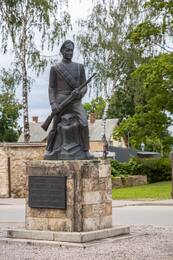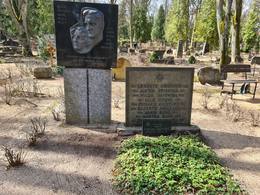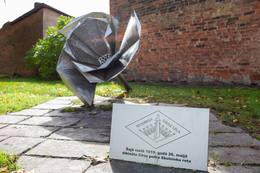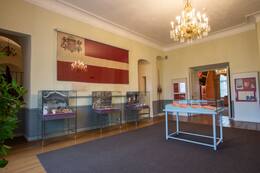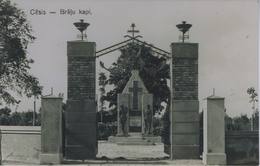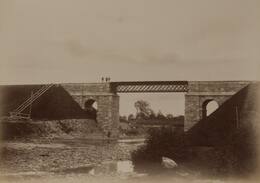Cėsių pulko moksleivių kuopa
I Nepriklausomybės karai
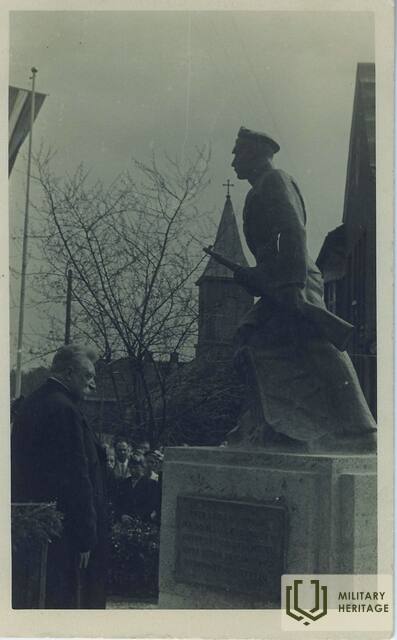
Cėsių pulko mokyklų kuopa buvo karinis dalinys, suformuotas iš Valmieros ir Cėsių mokyklų jaunimo 1919 m. gegužės ir birželio mėn. Cėsių mūšio išvakarėse. Kuopa dalyvavo Cėsių ir visuose vėlesniuose pulko mūšiuose.
1919 m. gegužės 26 d., kai Estijos kariuomenė išlaisvino Valmierą iš bolševikų, vadovaujant vietos vidurinės mokyklos kūno kultūros mokytojui Alfrēdiui Lukstiņusui (vėliau kuopos seržantui), prasidėjo savanorių mokinių registracija savigynos grupei, paremtai Estijos armijos mokinių kuopos modeliu, sukurti. Valmieroje pateikė paraiškas apie 70 jaunuolių, kurie buvo pasirengę prisijungti prie 2-ojo Cėsių pulko dalinių, kurie žygiavo iš Rūjienos per Valmierą į Latgalos frontą. Apie 40 Cėsių mokinių taip pat pradėjo formuoti savanorių vyresniųjų mokyklų dalinį pagal Valmieros mokinių modelį. Valmieros ir Cėsių mokinių iniciatyvą aktyviai palaikė Valmieros ir Cėsių vidurinių mokyklų direktoriai Ludvigas Adamovičius ir Longinas Ausėjas.
Birželio 5 d. buvusios Cėsių vokiečių progimnazijos patalpose Dārzos gatvėje įvyko Valmieros ir Cėsių jaunimo susivienijimas. Mokiniai, iš viso 108 žmonės, buvo įtraukti į 2-ojo Cėsių pėstininkų pulko 8-ąją kuopą (kuopa toliau buvo vadinama Mokinių kuopa), o kuopos vadu buvo paskirtas vyresnysis leitenantas Gustavas Grīns. Buvo planuota, kad kariniai mokymai prasidės kitą dieną, tačiau jau pirmąją naktį (iš birželio 5 į 6 d.) kai kurie kuopos kareiviai kaip vietiniai pažįstami buvo įsakyti į Estijos armijos šarvuotą traukinį. Kiti taip pat gavo šautuvus, o po kelių valandų buvo duotas įsakymas vykti į frontą Mācītājmuižos - Meijermuižos rajone, nes vokiečiai pradėjo puolimą. Po įnirtingos kovos Estijos ir Latvijos kariuomenės daliniai vis dėlto buvo priversti palikti Cėsius ir trauktis Liepos (Lodės) ir Raunos kryptimi.
Pirmajame mūšyje buvo sužeisti keli moksleiviai, tačiau tą pačią dieną nuo labai sunkios žaizdos skrandyje mirė Edgaras Krieviņš iš Valmieros. Nepriklausomybės karo metu kuopa neteko 9 kritusių ir žuvusių karių. Edgarui Krieviņam po mirties buvo įteiktas Lačplėšio karo ordinas. Pirmasis kuopos seržantas majoras Alfredas Lukstiņšas taip pat buvo apdovanotas LKO ordinu.
1929 m., artėjant Cėsių mūšio ir kuopos 10-mečiui, buvo įkurta Buvusio Cėsių pulko savanorių studentų kuopos atsargos karių draugija, kuri aktyviai dalyvavo jaunimo patriotiniame ugdyme. Svarbi draugijos tradicija siejama su Cėsių pulko studentų kuopos vėliava. Lėšas vėliavos gamybai paaukojo devynių Šiaurės Latvijos gimnazijų, kurių mokiniai į kuopą įstojo 1919 m., mokiniai ir mokytojai. Vėliavos projektą parengė buvęs kuopos karys, architektas Kārlis Dzirkalis. Vėliavos gamybą atliko septyni Cėsių valstybinės gimnazijos mokiniai, vadovaujami rankdarbių mokytojos Annos Brincevos. 1929 m. birželio 22 d. Cėsyse, Didvyrių atminimo dieną, įvyko iškilmingos Cėsių pulko savanorių studentų kuopos vėliavos pašventinimo pamaldos, po kurių Latvijos prezidentas Gustavas Zemgalas įteikė vėliavą kuopos organizatoriui, LKO kavalieriui A. Lukstiņui. Pirmaisiais metais vėliava buvo saugoma Cėsyse, tačiau 1930 m. buvo pradėta tradicija – buvusio Cėsių pulko studentų kuopos vėliava metams buvo perduota saugoti vienai iš Šiaurės Vidžemės gimnazijų. Nuo tada, gavus Švietimo ministerijos sutikimą, vėliava buvo saugoma: 1930 m. – Valmieroje, 1931 m. – Limbažiuose, 1932 m. – Mazsalacoje, 1933 m. – Rūjienoje, 1934 m. – Valkoje, 1935 m. – Alūksnėje, 1936 m. – Gaujienoje, 1937 m. – Smiltenėje, 1938 m. – vėl Cėsyse ir 1939 m. – Valmieroje. 1940 m. vėliava paskutinį kartą buvo perduota saugoti Limbažių gimnazijai. 1998 m. Cėsyse atidarius atnaujintą Pergalės paminklą, buvo atkurta Cėsių pulko Studentų kuopos keliaujančios vėliavos tradicija.
Daugiau informacijos šaltinių
Saulė nuo kalavijo patekėjo: prisiminimų ir dokumentų apie Cėsių pulko Studentų pulką 1919 m. rinkinys. Prisiminimus ir dokumentus spaudai parengė Tālis Pumpuriņš. - Cėsys, Cėsių muziejų asociacija, 1994. - p. 120.
Juris Ciganovs. Moksleivių kuopa 1919 m. mūšiuose. SARGS.LV 2011-05-31. https://www.sargs.lv/lv/latvijas-neatkaribas-kars/2011-05-31/skolnieku-rota-1919-gada-kaujas
Susijusi laiko juosta
Susijusios vietos
Paminklas Cėsių pulko studentams
Paminklas Cėsių pulko studentų kuopos kariams, žuvusiems Cėsių mūšiuose, yra Cėsių mieste, netoli Palasta ir Bērzaines gatvių sankryžos. Paminklo statybą pasiūlė Cėsių pulko studentų kuopos karių asociacija. Paminklas buvo atidengtas 1938 m. gegužės 26 d. Paminklas sukurtas pagal buvusio kuopos kario, dailininko Jānio Rozenbergo, eskizą. Ant metro aukščio kalkakmenio pjedestalo pastatytą 1,8 metro varinę skulptūrą, vaizduojančią karį, vilkintį moksleivio uniformą, sukūrė skulptorius Rūdolfs Āboltiņš ir varkalys Jānis Zibens. Prie kareivio kojų tupi pelėda – išminties ir žinių simbolis, gindama į karą išėjusio studento knygas. Skulptūra buvo nugriauta per pakartotinę sovietų okupaciją 1952 m. 1957 m. netoli buvusios jos vietos buvo pastatytas skulptoriaus Kārlio Jansonso sukurtas paminklas „Komjaunimo vėliavnešys“. Pastatytas netoli istorinės vietos, restauruotas paminklas buvo atidengtas 1992 m. lapkričio 11 d. Tuo pačiu metu, 1992 m., buvo nugriautas okupacinio režimo pastatytas komjaunimo paminklas.
Paminklas Moksleivių kuopos mūšio vietoje
Cėsių–Āraišų plento pakraštyje, netoli buvusių Livų parapijos namų.
Galima pamatyti paminklą, skirtą Cėsių pulko savanorių studentų kuopai, dalyvavusiai Cėsių mūšyje 1919 m.
Paminklas buvo atidengtas 1930 m. gegužės 29 d., šalia buvusių Livu parapijos namų.
Paminklo projektą parengė buvęs studentas savanoris K. Dzirkalis, o įrengimo darbus atliko A. Sprogio įmonė Cėsyje.
Bronzines detales pagal autoriaus brėžinį pagamino M. Pluka, o jos buvo nulietos V. Minuto gamykloje Rygoje. Po Antrojo pasaulinio karo paminklas buvo sunaikintas.
Atkurtas 1989 m. birželio 6 d., restauruoto paminklo autoriai buvo skulptoriai A. Jansons ir M. Baltiņa bei architektas I. Timermanis.
Vėliau dėl saugumo priežasčių bronzinis kardas ir plokštelė buvo pašalinti, pakeisti medinėmis dalimis.
Paminklas pirmajam žuvusiam Mokyklos kuopos kareiviui Edgarui Krieviniui
Įsikūręs Valmieros miesto centro kapinėse, šalia koplyčios (Miera g. 1/3, Valmiera)
Cėsių pulko 8-osios (Studentų) kuopos kareivis LKOK Edgaras Krieviņšas (1899–1919) mirė birželio 7 d. nuo sužalojimų, patirtų 1919 m. birželio 6 d. vykusiame Cėsių mūšyje, kai, priešui puolant, dengė likusių dalinių atsitraukimą.
Atminimo ženklas Cėsių pulko studentų kuopos įkūrimo vietoje
Įsikūręs Leona Paegles gatvėje 1, šalia raudonų plytų pastato fasado.
Memorialo autorė – menininkė Solveiga Vasiljeva, o idėja paremta žiedpumpurio motyvu. Kaip pastebi menininkė, jis simbolizuoja tik pradedančias formuotis asmenybes – studentus, kurie savo dar trumpame gyvenime turi priimti svarbų, atsakingą ir sunkų sprendimą.
Memorialo formoje žiedpumpuro išoriniai žiedlapiai yra geometrinio dizaino, su aštriais kampais, kontrastuojančiais su minkštais, apvaliais žiedlapiais pumpuro viduje. Memorialo aukštis siekia iki 1,5 m. Memorialas buvo atidengtas 2011 m. gegužės 26 d. Valmieroje, toje vietoje, kur 1919 m. buvo suformuota Cėsių pulko kadetų kuopa.
Latvijos kontūrai išdėlioti iš dirbtinių grindinio akmenų, ant kurių paguldyta lentelė su Cėsių pulko Mokinių kuopos vėliava ir tekstu:
„Šioje vietoje 1919 m. gegužės 26 d.
Įkurta „Cėsių pulko mokyklos kuopa“
Cėsių istorijos ir meno muziejus Cėsių Naujojoje pilyje
Cėsių istorijos ir meno muziejus yra įsikūręs pačiame Cėsių senamiesčio centre, Naujojoje pilyje. Muziejuje veikia nuolatinė istorijos ir interjero ekspozicija „Cėsys – Latvijos istorijos simbolis“, kurią sudaro du teminiai skyriai: ekspozicija „Raudona-balta-raudona vėliava Cėsių ir Latvijos istorijoje“ aiškina Latvijos nacionalinės vėliavos istoriją nuo XIII iki XX a., patvirtintą nacionalinį simbolį, Latvijos šaulių batalionų vėliavas ir nacionalinių spalvų naudojimo tradicijas Latvijos nepriklausomybės karo metu. Parodoje „Cėsys ir Latvijos nepriklausomybės karas“ daugiausia dėmesio skiriama Cėsių kuopos įkūrimui 1918 m. gruodžio mėn., bendroms estų ir latvių kovos pastangoms 1919 m. Cėsių mūšiuose, laikui, kai Bermonto aferos metu Cėsys trumpą laiką buvo laikinoji Latvijos sostinė, taip pat Cėsių pergalės paminklo istorijai. Pabėgimo kambaryje „Cėsių mūšių legendos“ dalyviai turi valandą rasti išeitį spręsdami galvosūkius, užmegzdami ryšius ir ieškodami paslėptų daiktų. Cėsių kuopa, vienas pirmųjų Latvijos ginkluotųjų pajėgų dalinių, buvo įkurta 1918 m. gruodžio 8 d. Cėsių pilyje vyresniojo leitenanto Artūrs Jansons. Muziejaus ekspozicijoje eksponuojama Cėsių kuopai skirta atminimo lenta, atidengta 1933 m. gruodžio 8 d. Cėsių Naujojoje pilyje, kuri tuo metu buvo 8-ojo Daugpilio pėstininkų pulko ir garnizono karininkų klubo štabas.
Cėsių brolių kapinės
Įsikūręs Cėsių Žemutinėse kapinėse, Lenču g. 15, Cėsis.
Viena reikšmingiausių Pirmojo pasaulinio karo ir Nepriklausomybės kovų memorialinių vietų Cėsyje yra Brolių kapinės Lejos Kapuose.
Kapinėse yra Cėsių menininko ir tarybos nario Augusto Jullos (1872–1958) suprojektuotas, 1927 m. atidengtas Brolių kapinių paminklas, skirtas 1915–1920 m. Brolių kapinėse palaidotiems kariams.
Cėsių Lėjos kapinių Brolių kapuose palaidota apie 200 kareivių. Tarp jų yra nežinomas skaičius Latvijos šaulių ir rusų kareivių, žuvusių Pirmajame pasauliniame kare, taip pat vokiečių (10), lenkų ir kitų tautybių kareivių. Latvijos išsivadavimo kovų metu šiose kapinėse palaidoti 22 5-ojo (2-ojo) Cėsių pėstininkų pulko kareiviai, taip pat 11 laisvės kovotojų, žuvusių kituose Latvijos armijos daliniuose. Brolių kapuose taip pat ilsisi 2 estai, 15 bolševikų aukų ir Latvijos raudonieji šauliai.
Geležinkelio tiltas per Amatą
Įsikūręs Cėsių rajone, Drabešių valsčiuje, šalia poilsio zonos „Meža kojas“.
Matomas geležinkelio tiltas per Amatos upę.
Geležinkelio tiltas per Amatos upę vaidina labai svarbų vaidmenį viso Nepriklausomybės karo metu, nes 1919 m. birželio 5 d. čia įvyko pirmasis mūšis tarp Estijos armijos šarvuočių ir Baltijos landesvero dalinių. Landesveras, žinodamas, kad artėja šarvuotasis traukinys, užminavo geležinkelio tiltą ir užėmė pozicijas „Amatos“ namuose upės krante, pasiruošęs galimiems karo veiksmams. Tiltas per Amatos upę buvo siena tarp Estijos pajėgų ir vokiečių.
Istorinių įrodymų apie įvykius prie Amatos tilto nėra išsaugota. Kadangi latviai šiuose įvykiuose nedalyvavo, nėra ir jų atsiminimų, yra estų kareivių prisiminimai, kiti šaltiniai. Galima teigti, kad tai buvo bendras estų ir amerikiečių mūšis prieš landesverą, nes estų šarvuotajame traukinyje buvo amerikiečių karininkas, kuris vėliau kovojo ir Antrajame pasauliniame kare. Apskritai Cėsių mūšiuose dalyvavo daug būsimų Antrojo pasaulinio karo karininkų ir vadų, ypač vokiečių pusėje.
Estijos šarvuotasis traukinys į Cėsį atvyko 1919 m. birželio 2 d., o po dienos nuvyko į Ierikius, kur vyko derybos su Landesveru, kurios buvo bevaisės, o birželio 5 d., kai šarvuotasis traukinys vėl artėjo prie Amatos tilto, prasidėjo susidūrimas su vokiečiais. Šarvuotasis traukinys po dienos dalyvavo ir mūšiuose prie Cėsių, kur padėjo Moksleivių kuopos kareiviams, kuriems grėsė apsuptis. Nors vokiečiai bandė išardyti bėgius, kad atkirstų traukinio atsitraukimo kelią, jam pavyko atsitraukti per Raunos tiltą.
1919 m. birželio 23 d. naktį, per Cėsių mūšį, landesveras paliko Cėsius ir atsitraukė prie Amatos upės. Atsitraukdami vokiečiai sudegino Cėsių latvių draugijos pastatą ir susprogdino tiltą per Amatą.
Susijusi istorija
Neįprasta Cėsių pulko mokyklos kuopos paminklo istorija
1919 m. Cėsių mūšiuose dalyvavo Cėsių pulko savanorių moksleivių kuopa, kuri birželio 5 d. buvusios Cėsių vokiečių progimnazijos patalpose Dārza gatvėje (dabar Bērzaines gatvė 4) susiformavo kaip kovinis vienetas iš 108 jaunuolių iš Valmieros ir Cėsių mokyklų. Jau naktį iš birželio 5 į 6 d., maždaug po valandos vidurnakčio, buvo paskelbtas aliarmas ir kuopai buvo įsakyta užimti pozicijas. Kuopa išėjo į Mācītājmuižos – Meijermuižos liniją, kuri buvo laikoma svarbiausia mūšio vieta.
Cėsių pulko studentų būriui skirtas paminklas prie buvusių Livu parapijos salės
1919 m. Cėsių mūšiuose dalyvavo Cėsių pulko savanorių moksleivių kuopa, kuri birželio 5 d. Cėsių progimnazijos patalpose susiformavo kaip kovinis vienetas iš 108 Valmieros ir Cėsių mokyklų jaunuolių. Jau naktį iš birželio 5 į 6 d., maždaug po valandos vidurnakčio, buvo paskelbtas aliarmas ir kuopai buvo įsakyta persikelti į pozicijas. Kuopa persikėlė į Mācītājmuižos - Meijermuižos liniją, kuri buvo laikoma svarbiausia mūšio vieta.
Pirmajame mūšyje buvo sužeisti keli moksleiviai, tačiau tą pačią dieną nuo labai sunkios pilvo žaizdos mirė Edgaras Krieviņšas, kilęs iš Valmieros. Jis buvo palaidotas su karine pagarba Valmieros miesto kapinėse birželio 13 d. Edgarui Krieviņam po mirties buvo įteiktas Lačplėšio karo ordinas.
Cėsių mūšio pradžia, eiga ir pabaiga
Pergalė Cėsių mūšyje turėjo tapti lūžio tašku Latvijos ir Estijos kovoje už savo šalies nepriklausomybę. Ši pergalė sustabdė Andrijevo Niedros vyriausybės ir vokiečių generolo Rüdigerio fon der Golco planus užkariauti Pabaltijį. Vietoj to, Liepojoje savo veiklą atnaujino Karlio Ulmanio vadovaujama Laikinoji Latvijos vyriausybė.





